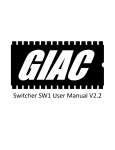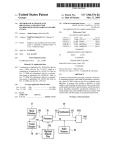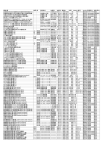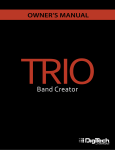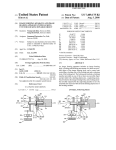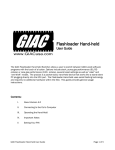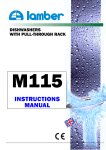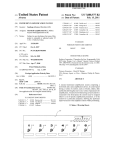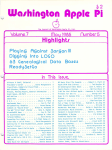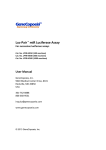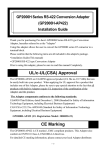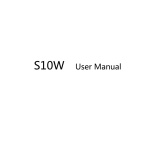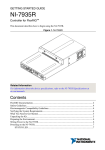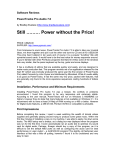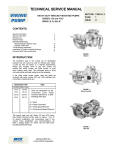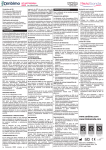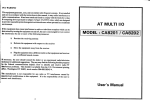Download Electronic musical instrument
Transcript
US007572968B2 (12) United States Patent (10) Patent N0.: (45) Date of Patent: Komano (54) ELECTRONIC MUSICAL INSTRUMENT (75) Inventor: FOREIGN PATENT DOCUMENTS Takeshi Komano, IWata (JP) (73) Assignee: Yamaha Corporation, Hamamatsu-Shi (JP) (*) Notice: US 7,572,968 B2 Aug. 11,2009 Subject to any disclaimer, the term of this patent is extended or adjusted under 35 EP EP JP JP JP JP JP 0 322 871 1 172 796 7-253780 11-282465 2000-224269 2003-208174 2004-219947 7/1989 1/2002 10/1995 10/1999 8/2000 7/2003 8/2004 OTHER PUBLICATIONS U.S.C. 154(b) by 219 days. Sonar 4 User’s Manual (Twelve Tone Systems. 2004). pp. 127, 165, (21) App1.No.:11/373,572 175, and 198).* WWW.pgmusic.com for teachings of modifying the registration (22) Filed: parameters of a song Within a song (e.g., style, tone color, tempo, Mar. 10, 2006 (65) etc.).* Image-Line Software “Getting Started”, FL Studio 4 Creative Edi tion, 2003, XP-002392365. Prior Publication Data US 2006/0219090 A1 (30) Oct. 5, 2006 * cited by examiner Foreign Application Priority Data Mar. 31, 2005 (JP) ........................... .. 2005-103404 Primary ExamineriDavid S. Warren (74) Attorney, Agent, or FirmiMorrison & Foerster LLP (57) ABSTRACT (51) Int. Cl. G10H 7/00 (2006.01) The present invention enables a user to select and control on (52) (58) US. Cl. ............................ .. 84/609; 84/615; 84/622 Field of Classi?cation Search ......... .. 84/600i609, an electronic musical instrument, just by selecting a registra 84/645, 615, 622 See application ?le for complete search history. (56) References Cited U.S. PATENT DOCUMENTS 5,138,925 A * 5,155,286 A 5,248,843 A 9/1993 Billings 5,668,334 A * 5,792,971 A 8/1992 Koguchi et al. ............. .. 84/609 10/1992 Saito et al. * 5,915,237 A * 9/1997 Kuribayashi et al. ........ .. 84/602 8/1998 Tirnis et al. 6/1999 Boss et al. ..... . . . . . .. 84/609 .. 704/2701 tion data set, the mode for generating musical tones, auto matic performance tones, and voice signals at once. More speci?cally, in a ROM 23 and external storage device 25 there are stored a plurality of registration data sets. Each registra tion data set includes a plurality of control parameters for controlling mode in Which musical tones are generated such as tone color and loudness, MIDI song specifying data for specifying MIDI song data (automatic performance data), and audio song specifying data for specifying audio song data (voice data). By selecting a registration data set by an opera tion of setting operators 12, the mode for generating musical tones is controlled in accordance With the control parameters With MIDI song data and audio song data being simulta 6,143,973 A * 11/2000 Kikuchi ..................... .. 84/645 neously reproduced in accordance With the selected registra 6,281,424 B1* 8/2001 Koike et a1. ................. .. 84/636 tion data set. 7,030,309 B2 2004/0055442 A1 4/2006 Kubita 3/2004 Terada 8 Claims, 12 Drawing Sheets ( bank setting ) processing S20 display screen for selecting registration bank select registration bank S22 S23 registration data setting enter into registration operators S26 Yes S24 US. Patent Aug. 11,2009 Sheet 3 0f 12 US 7,572,968 B2 FIG.3 MIDl song ?le D MlDl song?le E MIDI song ?le F audio song ?le d audio song ?le e audio song ?le f registration bank B4 registration bank B5 registration bank B10 FIG.4 tone color loudness tempo style transposition MIDI song specifying audio song specifying MlDl song data audio song data other control parameters, etc. US. Patent FIG.5 Aug. 11,2009 Sheet 4 0f 12 US 7,572,968 B2 @810 initial setting processing ~81 1 panel operation processing I S12 keyboard performance processing song data reproduction S14 processing FIG.6 bank setting S20 display screen for selecting registration bank (FIG. 15) select registration bank change name ~A S22 ~ $23 I registration data setting |~S24 enter into registration operators ~S25 Yes US. Patent Aug. 11,2009 Sheet 5 0f 12 US 7,572,968 B2 FIG.7 ( registration data setting F330 selectively display registration data ~S31 (1 to 4) in bank I change contents of registration data ~S32 I save ~ S33 N° m 834 Yes @ S35 FIG.8 ( registration data reading )—~S40 read registration data set entered in operated ~S41 registration operator into RAM I read MIDI song data and audio song data speci?ed by MIDI ~ S42 song specifying data and audio song specifying data into RAM US. Patent Aug. 11,2009 Sheet 6 0f 12 US 7,572,968 B2 FIG.9 C audio song data reading >~S45 successively read a given amount of audio song into RAM FIG. 10 ( MIDIinstruction song operator ) S51 operator for starting reproduction of MIDI song data operated? IYes MRN1<—"1" S50 W? ~S52 <reproduction operator forofstopping MIDI song 2 0U) data operated‘? IYes MRNh-"O" ( return ~s54 F855 01 co US. Patent Aug. 11,2009 Sheet 7 0f 12 US 7,572,968 B2 FIG.1 1 (audio song operator instruction . operator for starting S60 S61 No reproduction of audio song - data operated? Yes ARNV-"i" ~S62 operator for stopping N086?’ reproduction of audio song data operated? Yes ARN1<—"0" ( return ~ 564 F’ 865 US. Patent Aug. 11,2009 Sheet 8 0f 12 US 7,572,968 B2 FIG.12 MIDI song S100 re - roduction S101 MRN1="1"? Yes registration data contains 3102 No MlDl song specifying data? / 1 /-S103 display statement "MIDI Yes MRN2: O ? N 8105 o song has not been speci?ed" on display unit Yes r8106 set tempo count value to initial value r8107 increment tempo count value [-8104 MRN1‘—"0" r8108 timing data indicative \No of tempo count value contained? / Was $109 musical tone control No event (note-on/ off)? Yes r8110 control tone generator in accordance with event data S111 No event for starting (or terminating) audio song? [Yes ARN1‘—"1"(0r"0") ~S112 end data? l \/ S1 13 No US. Patent Aug. 11,2009 Sheet 9 0f 12 US 7,572,968 B2 FIG.13 registration data contains NS°123 audio song specifying data? Yes r8126 r8124 Output audio Song (13118 to display statement "audio Sound sy§tem m song has not been accordance ‘.N'th passage speci?ed" on display unit of tlme I I reproduction of audio song data completed? 3127 No ARN1 [-8125 <--" " 0 IYes ARN1‘—"0" S128 ARNZFARNl ~S129 MIDI song — audio song _ I? II] [JD 0 I} E] mu 0 12g 12i ' l —_— select bank dlsplay setting 12b ) 12j registration freeze @515 12a l 12h 12c we 12d I2e 12f US. Patent Aug. 11,2009 Sheet 10 0f 12 US 7,572,968 B2 FIG.15 select registration bank I registration B1 I I registration B6 I I registration B2 I I registration B3 I I registration B8 I I registration B4 j I registration B9 I I registration B5 I I registration B1 0 j US 7,572,968 B2 1 2 ELECTRONIC MUSICAL INSTRUMENT a plurality of setting operators provided on an operating BACKGROUND OF THE INVENTION panel, an automatic performance data storage portion for storing a plurality of automatic performance data strings each composed of a performance data string for controlling gen 1. Field of the Invention The present invention relates to an electronic musical eration of a string of musical tone signals that form a song, and a voice data storage portion for storing a plurality of voice instrument in Which the mode for generating musical tones is controlled through the use of registration data composed of a data strings each composed of a data string representative of plurality of control parameters for controlling the mode for generating musical tones, the mode being speci?ed by a plu rality of setting operators provided on an operating panel. 2. Description of the Related Art As shoWn in Japanese Patent Laid-Open Publication No. includes automatic performance specifying data for specify a voice signal Wherein each of the registration data sets ing any one of the automatic performance data strings and voice specifying data for specifying any one of the voice data strings. In this case, voice data (i.e., audio song data) indicates audio data in Which, for example, human singing voices, 07-253780, there has been a Well-knoWn registration func tion. In the registration function, musical tone control param eters such as tone color data representative of a tone color of a musical tone to be generated, loudness data representative of the loudness of a musical tone to be generated, style data for specifying the type of accompaniment tones, effect data representative of an effect to be added to a musical tone to be generated are previously stored in a memory as a set of 20 voices of musical instruments, and effect tones (natural tones and synthesiZed tones) are digitally converted or digitally compressed. As for the audio data, audio signals can be repro duced merely by use of a digital-to-analog converter. Further more, the electronic musical instrument may include a regis tration control portion for loading into a temporary storage portion, When one of the registration data sets is selected, not registration data. Alternatively, the registration data set is only control parameters contained in the selected registration speci?ed by a user through the use of a plurality of setting operators provided on an operating panel and is Written into the memory. In this conventional scheme, each registration data set is assigned to a button to make it possible to read out a registration data set With single button operation even dur ing performance of a song, enabling the user to establish the data set but also an automatic performance data string and a voice data string speci?ed respectively by automatic perfor 25 cal instrument controls mode in Which a musical tone is generated, emits an automatic performance tone and gener ates a voice signal on the basis of the control parameters, the mode for generating musical tones on an electronic musical instrument in a short time. Recently, in addition, another type mance specifying data and voice specifying data contained in the selected registration data set, Wherein the electronic musi 30 of electronic musical instrument came on the market. In this electronic musical instrument, a set of registration data also automatic performance data string and the voice data string loaded into the temporary storage portion. In the feature of the present invention con?gured as above, contains automatic performance specifying data for specify each registration data set contains a plurality of control ing a set of automatic performance data (MIDI song data) so that the user’s selection of a registration data set folloWed by parameters, automatic performance specifying data and voice 35 the user’s operation of a reproduction start sWitch causes generation of automatic performance tones on the basis of the specifying data, enabling a user to specify the mode in Which musical tones are generated, automatic performance data and voice data at once only by selecting a registration data set. As automatic performance data set speci?ed by the automatic a result, the feature of the present invention enables the user to performance specifying data. play a melody part While generating accompaniment tones on In the above-described conventional apparatuses, hoWever, 40 voice data (audio song data) representative of voice signal cannot be automatically speci?ed on the basis of registration data. Therefore, the conventional electronic musical instru ments are unable to play a melody part While generating accompaniment tones on the basis of previously recorded tones during a performance by the user or during reproduc tion of automatic performance tones on the basis of automatic performance data, providing the user With enriched music. 45 It is another feature of the present invention to provide an electronic musical instrument comprising the registration data storage portion, the automatic performance data storage portion, and the voice data storage portion, Wherein each of voice data or to add an audio song or audio phrase as back ground music (BGM) or effect tones during a performance by a user or during reproduction of automatic performance tones on the basis of automatic performance data. the registration data sets includes one of tWo type of specify 50 SUMMARY OF THE INVENTION ing data: automatic performance specifying data for specify ing any one of automatic performance data strings and voice specifying data for specifying any one of voice data strings, and the other of the tWo types of specifying data: the auto The present invention Was accomplished to solve the above-described problem, and an object thereof is to provide an electronic musical instrument in Which not only musical the basis of previously recorded voice data or to add an audio song or audio phrase as background music (BGM) or effect matic performance specifying data and the voice specifying 55 tone control parameters and automatic performance data but also voice data are automatically speci?ed by registration data is included in automatic performance data string or voice data string speci?ed by the one of the tWo types of specifying data. data in order to enable a user to select and control at once, just In this case as Well, voice data indicates audio data in by selecting a registration data set, the mode for generating musical tones, the automatic performance tones, and the Which, for example, human singing voices, voices of musical 60 instruments, and effect tones are digitally converted or digi voice signals. tally compressed. Furthermore, the electronic musical instru In order to achieve the above-described object, it is a fea ture of the present invention to provide an electronic musical ment may include a registration control portion for loading into a temporary storage portion, When one of the registration data sets is selected, not only control parameters contained in the selected registration data set but also an automatic perfor instrument comprising a registration data storage portion for storing a plurality of registration data sets each composed of a plurality of control parameters for controlling mode in Which a musical tone is generated, the mode being de?ned by 65 mance data string or a voice data string speci?ed by the one of the tWo types of specifying data contained in the selected US 7,572,968 B2 4 3 registration data set as well as loading, into the temporary storage portion, an automatic performance data string or a only as an invention of an apparatus but also as an invention voice data string speci?ed by the other specifying data of a computer program and a method applied to the apparatus. included in the automatic performance data string or voice data string, wherein the electronic musical instrument con BRIEF DESCRIPTION OF THE DRAWINGS Furthermore, the present invention can be embodied not trols mode in which a musical tone is generated, emits an automatic performance tone and generates a voice signal on FIG. 1 is a block diagram showing the general arrangement of an electronic musical instrument according to an embodi the basis of the control parameters, the automatic perfor mance data string and the voice data string loaded into the ment of the present invention; temporary storage portion. the electronic musical instrument; FIG. 2 is a memory map showing data stored in a ROM of In this feature of the present invention con?gured as above, each registration data set contains not only a plurality of control parameters but also one of two types of specifying data: the automatic performance specifying data and the voice specifying data, while the other of the two types of specifying data is included in automatic performance data or voice data FIG. 3 is a memory map showing data stored in a hard disk of the electronic musical instrument; FIG. 4 is a memory map showing data stored in a RAM of the electronic musical instrument; FIG. 5 is a ?owchart showing a main program executed on the electronic musical instrument; speci?ed by the one of the specifying data. Only by selecting a registration data set, therefore, the user can specify the mode in which musical tones are generated, automatic performance data and voice data at once. As a result, this feature of the present invention also enables the user to play a melody part while generating accompaniment tones on the basis of voice 20 data or to add an audio song or audio phrase as background music (BGM) or effect tones during a performance by the user or during reproduction of automatic performance tones on the basis of automatic performance data, providing the user with enriched music. In addition, since a registration data set contains only one of the two types of specifying data with the other specifying data being contained in automatic per formance data or voice data speci?ed by the one of the speci fying data, this feature of the present invention enables the user to establish the other specifying data at the disposal of the user to realiZe effective reproduction of the both data and facilitated synchronous reproduction. 25 30 instructing routine executed at the panel operation process in 35 40 the automatic performance data storage portion stores the of a timing at which a musical tone signal is generated in a FIG. 15 is a screen for selecting a registration bank dis song, and the voice specifying data is embedded in the per 45 ground music (BGM) and effect tones such as audio song and audio phrase at user’s desired timing during an automatic performance on the basis of automatic performance data. It is a further feature of the invention to provide an elec played on a display unit of the electronic musical instrument; FIG. 16 is a screen for setting registration data displayed on the display unit of the electronic musical instrument; and FIG. 17 is a memory map showing data stored in a ROM of an electronic musical instrument according to a modi?ed example. 50 DESCRIPTION OF THE PREFERRED EMBODIMENT tronic musical instrument wherein the registration control portion loads into the temporary storage portion, at the time of selecting a registration data set from among the registration data sets, only the top part of voice data string speci?ed by the voice specifying data. In this case, the remaining voice data may be then loaded into the temporary storage portion at every given timing, at every time a given amount of voice data written into the temporary storage portion has been repro duced with remaining voice data in the temporary storage portion that has not been reproduced falling below a given amount, at idle times during other program processing, or the the main program; FIG. 12 is a ?owchart showing a MIDI song reproduction routine executed at a song data reproduction process in the main program; FIG. 13 is a ?owchart showing an audio song reproduction routine executed at the song data reproduction process in the main program; FIG. 14 is a magni?ed view ofpart ofan operating panel of the electronic musical instrument; performance data string along with timing data representative formance data string along with the timing data. This feature of the invention realiZes automatic reproduction of back instructing routine executed at the panel operation process in the main program; FIG. 11 is a ?owchart showing an audio song operator It is still another feature of the invention to provide an electronic musical instrument wherein the one of the two types of specifying data is automatic performance specifying data while the other specifying data is voice specifying data, FIG. 6 is a ?owchart showing a bank setting process routine executed at a panel operation process in the main program; FIG. 7 is a ?owchart showing a registration data setting routine executed at the panel operation process in the main program; FIG. 8 is a ?owchart showing a registration data reading routine executed at the panel operation process in the main program; FIG. 9 is a ?owchart showing an audio song data reading routine executed at the panel operation process in the main program; FIG. 10 is a ?owchart showing a MIDI song operator 55 An embodiment of the present invention will now be described with reference to the drawings. FIG. 1 is a block diagram schematically showing an electronic musical instru ment according to the present invention. The electronic musi cal instrument is provided with a keyboard 11, setting opera tors 12, a display unit 13 and a tone generator 14. like. Even in a case where the amount of voice data is so The keyboard 11 is composed of a plurality of keys used as performance operators for specifying the pitch of a musical tone to be generated. The operation of the respective keys is massive as to require much time to load the data into the detected by a detecting circuit 16 connected to a bus 15. The 60 temporary storage portion, this feature avoids insuf?cient storage area for the voice data in the temporary storage por tion as well as prolonged time required until reproduction of the voice data. detecting circuit 16 also includes a key touch sensing circuit 65 for sensing the velocity of a key depression of the respective keys, and outputs a velocity signal representative of the veloc ity of a key depression at each key depression. The setting US 7,572,968 B2 5 6 operators 12 are provided on an operating panel of the elec tronic musical instrument and are composed of a plurality of and other data. The preset data units are the data neces sary for operations of the electronic musical instrument such as mode setting operators for providing instructions regarding behav for generating musical tones. The processing programs are the fundamental programs for making the CPU 21 active. iors of respective parts of the electronic musical instrument, particularly, instructions regarding mode for generating The MIDI song ?les are the ?le for storing an automatic musical tones and registration data. The operation of the performance data string composed of a performance data string for controlling generation of a string of musical tone respective setting operators is detected by a detecting circuit 17 connected to the bus 15. The display unit 13 is con?gured by a liquid crystal display, a CRT or the like provided on the signals that form a song. For the present embodiment there are provided three demonstration ?les of ?les A, B and C. Each MIDI song ?le is composed of an initial data unit and a operating panel, displaying characters, numerals, graphics, plurality of track data units (e.g., 16 track data units). The initial data unit is composed of control parameters about etc. What is displayed on the display unit 13 is controlled by a display control circuit 18 that is connected to the bus 15. The tone generator 14, Which is connected to the bus 15, general matters of a song that are de?ned at the start of an automatic performance such as performance tempo, style (type of accompaniment), loudness of musical tones, loud generates digital musical tone signals on the basis of perfor mance data and various musical tone control parameters sup plied under the control of a later-described CPU 21, and outputs the signals to a sound system 19. The tone generator 14 also includes an effect circuit for adding various musical effects such as chorus and reverb to the above-generated digital musical tone signals. The sound system 19, Which includes digital-to-analog converters, ampli?ers and the like, converts the above-supplied digital musical tone signals to analog musical tone signals and supplies the analog musical ness balance betWeen musical tones, transposition, musical effects. Each of the track data units corresponds to a part such as melody, accompaniment and rhythm, being composed of ini 20 data of a track data unit is composed of control parameters about matters on the track (part) that are de?ned at the start of an automatic performance such as tone color of musical tone signals to speakers 1911. To the sound system 19 there are also supplied digital voice signals from the CPU 21 through 25 the bus 15. The sound system 19 also converts the supplied digital voice signals to analog voice signals and supplies to 30 keyboard 11), being composed of note-on data, note number 35 are attachable to the electronic musical instrument. The exter data and velocity data. Note-on data represents the start of generation of a musical tone signal (key-depression on the keyboard 11). Note number data represents the pitch of a musical tone signal (key on the keyboard 11). Velocity data that are previously incorporated in the electronic musical instrument, and compact disk CD and ?exible disk FD that nal storage device 25 also includes drive units for the storage media to enable storing and reading of data and programs that Will be described later. Those data and programs may be previously stored in the external storage device 25. Alterna tively, those data and programs may be externally loaded through the communications interface circuit 26. In the ROM the start of an automatic performance. Event data includes at least note-on event data, note-off event data, and audio song start (or completion) event data. Note-on event data represents the start of generation of a musical tone signal (corresponds to performance data on the The electronic musical instrument also includes a CPU 21, timer 22, ROM 23 and RAM (a temporary storage portion) 24 that are connected to the bus 15 and compose the main body of a microcomputer. The electronic musical instrument also has an external storage device 25 and a communications interface circuit 26. The external storage device 25 includes various storage media such as hard disk HD and ?ash memory tones, loudness of musical tones, and effect added to musical tones. Each timing data unit corresponds to an event data unit, representing the control timing for the event data unit. The timing data is absolute timing data representative of the abso lute time (i.e., bar, beat, and timing in a beat) measured from the speakers 19a. The speakers 19a emit musical tones and voices corresponding to the supplied analog musical tone signals and analog voice signals. tial data, timing data, various event data, and end data. Initial 40 represents the loudness level of a musical tone signal (veloc ity of a key-depression on the keyboard 11). Note-off event data is composed of note-off data and note number data. Note-off data represents the completion of generation of a musical tone signal (key-release on the keyboard 11). Note number data is the same as the one described in the case of the 45 note-on event data. Audio song start event data represents the 23 as Well there are previously stored various data and pro start of reproduction of audio song data. Audio song comple tion event data represents the completion of reproduction of grams. At the time of controlling the operation of the elec tronic musical instrument, furthermore, various data and pro audio song data. End data represents the completion of an automatic performance of a track. Event data may include grams are transferred to be stored from the ROM 23 or the external storage device 25 to the RAM 24. The communications interface circuit 26 is capable of con necting to an external apparatus 31 such as another electronic musical instrument or a personal computer to enable the electronic musical instrument to exchange various programs and data With the external apparatus 31. The external connec tion through the communications interface circuit 26 can be done via a communications netWork 32 such as the Internet, enabling the electronic musical instrument to receive and transmit various programs and data from/to outside. Next explained Will be data and programs that are previ ously stored in the ROM 23 and the external storage device 25 or transferred and stored in the RAM 24. Previously stored in the ROM 23 are, as shoWn in FIG. 2, a plurality of preset data units, a plurality of processing programs, a plurality of MIDI song ?les, a plurality of audio song ?les, a plurality of regis tration banks each having a plurality of registration data sets, 50 control parameters for controlling mode for generating musi cal tones (tone color, loudness, effect and the like) to change the mode in Which musical tones are generated during an automatic performance. 55 The respective audio song ?les correspond to respective voice data strings each composed of a data string representa tive of voice signals. For the present embodiment there are provided three ?les of a, b and c. Each of the audio song ?les is composed of administration data and voice data. Adminis 60 tration data is data on decoding required for reproducing voice data. Voice data is digital audio data in Which human voices, voices of musical instruments and effect tones are digitally converted or digitally compressed. 65 Each of the registration data sets is composed of a plurality of control parameters for controlling the mode in Which musi cal tone signals are generated, the mode being speci?ed through the use of the setting operators 12 on the operating panel. In the present embodiment, 12 sets of registration data US 7,572,968 B2 7 8 B1-1, B1-2 . . . are provided for use in demonstration, being data composed of note-on data representative of a key-de pression, note number data representative of the depressed classi?ed under three registration banks B1, B2 and B3. Each registration data set includes a plurality of control parameters for controlling tone color of musical tones, loudness of musi key, and velocity data representative of the velocity of the cal tones, style (type of accompaniment), performance tempo, transposition, loudness balance betWeen musical tones, musical effect, and the like. Each registration data set also contains MIDI song specifying data and audio song specifying data. MIDI song specifying data is the data for specifying a MIDI song ?le (automatic performance data), being composed of path information indicative of the location Where the MIDI song ?le is stored and data representative of its ?lename. Audio song specifying data is the data for speci fying an audio song ?le (voice data), being composed of path information indicative of the location Where the audio song ?le is stored and data representative of its ?lename. Stored in the external storage device 25 are, as shoWn in FIG. 3, a plurality of MIDI song ?les D, E, F . . . , a plurality of audio song ?les d, e, f . . . , a plurality of registration banks each having a plurality of registration data sets. The MIDI 20 song ?les D, E, F . . . and the audio song ?les d, e, f. . . are con?gured similarly to the MIDI song ?lesA, B and C and the audio song ?les a, b and c stored in the ROM 23, respectively. The present embodiment is provided With seven registration banks of B4 through B10, each capable of having four regis 25 tration data sets. The respective registration data sets are con?gured similarly to those stored in the ROM 23. The MIDI song ?les, audio song ?les and registration data stored in the external storage device 25 may be created by a user through program processing that Will be described later. Alternatively, 30 (voice data). These controls Will be detailed later With refer Next explained Will be processing on registration data. When the user operates the setting operators 12 to provide instructions for selecting a registration bank, the CPU 21 starts a bank setting processing routine at the panel operation processing of step S12 of FIG. 5. The bank setting processing routine shoWn in FIG. 6 is started at step S20. At step S21, a 35 screen for selecting a registration bank (see FIG. 15) is dis played on the display unit 13. The selection of a registration bank is done by operating a bank selecting operator 12a shoWn in FIG. 14 Which enlarges part of the setting operators Writing a set of registration data (see FIG. 2) and the area for storing MIDI song data (automatic performance data) and audio song data (voice data) respectively speci?ed by MIDI song specifying data and audio song specifying data con tained in the registration data set. In the RAM 24 there are also as generation of audio signals on the basis of audio song data ence to ?oWcharts shoWn in FIG. 12 and FIG. 13. those ?les and data stored in the external storage device 25 may be loaded via the communications interface 26 from the external apparatus 3 1 or an external apparatus connected With the communications netWork 32. In the RAM 24, as shoWn in FIG. 4, there are the area for key-depression is supplied to the tone generator 14. In response to the supplied performance data, the tone generator 14 starts generating a digital musical tone signal having the pitch and loudness that correspond to the supplied note num ber data and velocity data, respectively. The tone generator 14 then emits a musical tone corresponding to the digital musical tone signal through the sound system 19 and the speakers 19a. In this case, the tone color, loudness and the like of the digital musical tone signal generated by the tone generator 14 are de?ned under the control on the mode for generating musical tones that includes registration data processing. When the depressed key is released, the CPU 21 controls the tone gen erator 14 to terminate the generation of the digital musical tone signal. The emission of the musical tone corresponding to the released key is thus terminated. Due to the above described keyboard performance processing, a musical per formance on the keyboard 11 is played. At song data reproduction processing of step S14, the CPU 21 controls generation of automatic performance tones on the basis of MIDI song data (automatic performance data) as Well 12. On the screen for selecting a registration bank, if the user operates the setting operators 12 such as one click of a mouse 40 on a desired registration bank displayed on the registration stored other control parameters for controlling the operation bank selecting screen, the desired registration bank is of the electronic musical instrument. selected. ShoWn in FIG. 15 is a state in Which a registration bank B7 has been selected. After the selection of a registration The operation of the electronic musical instrument con?g ured as described above Will noW be described With reference to ?oWcharts shoWn in FIG. 5 through FIG. 13. When a user turns on a poWer sWitch (not shoWn) of the electronic musical instrument, the CPU 21 starts executing a main program at bank, if the user operates the setting operators 12 to change 45 step S10 shoWn in FIG. 5. At step S11 the CPU 21 executes processing for establishing initial settings for activating the electronic musical instrument. After the initial setting, the 50 CPU 21 repeatedly executes circulating processing consist ing of steps S12 to S15 until the poWer sWitch is turned off. When the poWer sWitch is turned off, the CPU 21 terminates the main program at step S16. While the circulating processing is in process, by panel operation processing of step S12 the CPU 21 controls and changes, in response to the user’s operation on the setting operators 12, the mode in Which the electronic musical instru ment operates, particularly, the mode in Which musical tones are generated (tone color, loudness, effect and the like). 55 At this state, if the user operates a display setting operator 12b, the CPU 21 executes, at step S24, a registration data setting routine shoWn in FIG. 7 to alloW modi?cation to any one of the registration data sets (four sets in the present embodiment) in the selected registration bank. The modi?ca tion to registration data can be done only to the registration banks B4 through B10 provided in the external storage device 25. The registration data setting routine is started at step S30. At step S31, the CPU 21 selectively displays the contents (contents of control parameters) of the four registration data sets in the registration bank. When the display setting opera tor 12b is ?rstly operated at the display state shoWn in FIG. 15, 60 Operations de?ned by registration data that directly relates to the present invention Will be detailed later With reference to ?oWcharts shoWing routines shoWn in FIG. 6 to FIG. 11. At keyboard performance processing of step S13, the CPU 21 controls generation of musical tones in accordance With user’s performance on the keyboard 11. More speci?cally, When a key on the keyboard 11 is depressed, performance the name of the registration bank, the name of the selected registration bank is changed by the process of step S23. 65 more speci?cally, the contents of the ?rst registration data set in the selected registration bank are displayed on the display unit 13. ShoWn in FIG. 16 is a display state in Which the contents of the registration data B7-1 in the registration bank B7 are displayed on the display unit 13. After the ?rst opera tion of the display setting operator 12b, each time the display setting operator 12b is operated, the contents of the second, third and fourth registration data set in the selected registra tion bank are successively displayed. US 7,572,968 B2 9 10 therefore, When a registration data set is speci?ed by operat ing the registration operator 120 to 12for When a registration At the display state of FIG. 16, if the user operates the setting operators 12 to modify the contents of the registration data, the CPU 21 modi?es the contents of the registration data by the process of step S32. More speci?cally, if the user clicks data set is speci?ed in the other Way that Will be described later, only the top of audio song data speci?ed by audio song With a mouse any one of triangles each corresponding to a 5 control parameter item shoWn in FIG. 16, possible options for the clicked control parameter are displayed on the display unit 13. If the user then clicks any one of the displayed options With the mouse, the content of the control parameter is changed to the selected option. If the user then operates the setting operators 12 to update the registration data such as clicking a mark “SAVE” in FIG. 16 With the mouse, the CPU 21 updates, by the process of step S33, the selected registra tion data in the external storage device 25 to the state dis played on the display unit 13 (i.e., the contents of the regis tration data shoWn in FIG. 16). After the modi?cation to the registration data in the external storage device 25, if the user operates the setting operators 12 to terminate the setting of the registration data, the CPU 21 gives “Yes” at step S34 and terminates the registration data setting routine at step S35. The bank setting processing routine shoWn in FIG. 6 Will noW be described again. At the display state ofFIG. 15, i.e., at the display state in Which a registration bank has been selected, if the user operates the setting operators 12 to enter registration data sets into four registration operators 120 to reads from the ROM 23 or the external storage device 25 a given amount of audio song data (voice data) speci?ed by audio song specifying data and Writes into the RAM 24. The CPU 21 then terminates the audio song data reading routine at 20 step S47. Next explained Will be the reproduction of MIDI song data (automatic performance data) and audio song data (voice data). If the user operates the setting operators 12 (e.g., an 25 12f (see FIG. 14) contained in the setting operators 12, four registration data sets in the selected registration bank are entered in the registration operators 120 to 12], respectively. The data representative of the entry of the registration data into the registration operators 120 to 12fis stored in the RAM specifying data may be Written into the RAM 24. As for the remaining audio song data, the audio song data reading routine shoWn in FIG. 9 is executed to read the remaining audio song data at every given timing, at every time a given amount of voice data Written into the RAM 24 has been reproduced by a later-described process With remaining audio data in the RAM 24 that has not been reproduced falling beloW a given amount, at idle times during other program processing, or the like. The audio song data reading routine is started at step S45. At step S46, the CPU 21 successively operator 12g for starting reproduction of a MIDI song or an operator 12h for stopping reproduction of a MIDI song shoWn in FIG. 14) to start reproduction of MIDI song data or to stop reproduction of MIDI song data, the CPU 21 executes, at the panel operation processing of step S12 in FIG. 5, a MIDI song operator instructing routine shoWn in FIG. 10. The MIDI song operator instructing routine is started at step S50. When the 24. In the display state of FIG. 15, more speci?cally, by a user instructs to start reproduction of MIDI song data, the CPU 21 sets, by processes of steps S51, S52, a neW MIDI double-click With a mouse on any one of the displayed reg running ?ag MRN1 to “l” indicative of the state Where MIDI istration banks B1 to B10, for example, the entry of the registration data sets into the registration operators 120 to 12f is instructed. If the user then operates the setting operators 12 to terminate the registration bank setting processing, the CPU 21 gives “Yes” at step S26 and terminates the bank setting processing routine at step S27. 30 song data is reproduced. When the user instructs to stop 35 “0” indicative of the state Where MIDI song data is not repro duced. If the user operates the setting operators 12 (e.g., an opera Next explained Will be a case in Which the user uses regis tration data for the user’ s performance on the keyboard 11. In this case, if the user operates any one of the registration operators 120 to 12f shoWn in FIG. 14, the CPU 21 executes, at the panel operation processing of step S12 in FIG. 5, a registration data reading routine shoWn in FIG. 8. The regis tration data reading routine is started at step S40. At step S41, the CPU 21 reads the registration data set entered in the operated registration operator 120 to 12ffrom the ROM 23 or tor 121' for starting reproduction of an audio song or an opera 40 45 the external storage device 25 and Writes into the RAM 24. As shoWn in FIG. 4, in other Words, in addition to the control parameters for controlling the mode for generating musical tones such as tone color, loudness, tempo, style and the like, MIDI song specifying data and audio song specifying data is also Written into the RAM 24. At step S42, the CPU 21 then reads MIDI song data (automatic performance data) and audio song data (voice data) that is respectively speci?ed by 50 At the song data reproduction processing of step S14 in 55 Written into the RAM 24 from the ROM 23 or the external storage device 25. CPU21 Writes the read MIDI song data and audio song data into RAM24. The CPU 21 then terminates the 60 until reproduction of the audio song data. In such cases, FIG. 5, a MIDI song reproduction routine shoWn in FIG. 12 and an audio song reproduction routine shoWn in FIG. 13 are repeatedly executed at given short time intervals. The MIDI song reproduction routine is started at step S100. At step S101, the CPU 21 determines Whether the reproduction of MIDI song data has been currently instructed by determining Whether the neW MIDI running ?ag MRN1 is at “1”. If the neW MIDI running ?ag MRN1 is at “0” to indicate that the reproduction of MIDI song data is not currently instructed, audio song data may be Written into the RAM 24. In some cases, more speci?cally, the amount of audio song data (voice data) is massive, resulting in insuf?cient storage area for the audio song data in the RAM 24 or prolonged time required tor 12j for stopping reproduction of an audio song shoWn in FIG. 14) to start reproduction of audio song data or to stop reproduction of audio song data, the CPU 21 executes, at the panel operation processing of step S12 in FIG. 5, an audio song operator instructing routine shoWn in FIG. 11. The audio song operator instructing routine is started at step S60. When the user instructs to start reproduction of audio song data, the CPU 21 sets, by processes of steps S61, S62, a neW audio running ?ag ARN1 to “l” indicative of the state Where audio song data is reproduced. When the user instructs to stop reproduction of audio song data, the CPU 21 sets, by pro cesses of steps S63, S64, the neW audio running ?agARN1 to “0” indicative of the state Where audio song data is not repro duced. the MIDI song specifying data and audio song specifying data registration data reading routine at step S43. At step S42, the entire audio song data (voice data) may be Written into the RAM 24. Alternatively, only the top of the reproduction of MIDI song data, the CPU 21 sets, by pro cesses of steps S53, S54, the neW MIDI running ?ag MRN1 to 65 the CPU 21 gives “No” at step S101 and sets, at step S115, an old MIDI running ?ag MRN2 to “0” indicated by the neW MIDI running ?ag MRN1. The CPU 21 then temporarily terminates the MIDI song reproduction routine at step S116. US 7,572,968 B2 11 12 music that is automatically performed on the basis of MIDI If the new MIDI running ?ag MRN1 is at “1” to indicate that the reproduction of MIDI song data has been currently instructed, the CPU 21 gives “Yes” at step S101 and deter mines at step S102 Whether registration data in the RAM 24 contains MIDI song specifying data. If MIDI song specifying data is not contained, the CPU 21 gives “No” at step S102, and song data (automatic performance data) speci?ed by MIDI song specifying data is played. At step S111, the CPU 21 then determines Whether the event data corresponding to the timing data is an event for starting an audio song or an event for terminating an audio at step S103 displays on the display unit 13 a statement saying “MIDI song has not been speci?ed”. At step S104 the CPU 21 also changes the neW MIDI running ?ag MRN1 to “0”. The CPU 21 then executes the above-described process of step song. If the event data is not for starting or terminating an audio song, the CPU 21 proceeds to step S113. If the event data is an event for starting an audio song, the CPU 21 sets, at S115, and temporarily terminates the MIDI song reproduc step S112, the neW audio running ?ag ARN1 to “1”. If the tion routine at step S116. In this case, since “No” Will be given at step Sl01 for the later processing, the processes of steps event data is an event for terminating an audio song, the CPU S102 to S114 Will not be carried out. Next explained Will be a case in Which registration data in the RAM 24 contains MIDI song specifying data. In this case, after the determination of “Yes” at step S102, the CPU 21 determines at step S105 Whether it is just the time to start reproducing MIDI song data by determining Whether the old MIDI running ?ag MRN2 indicative of the previous instruc 20 tion for reproduction of MIDI song data is at “0”. If it is determined that it is just the time to start reproducing MIDI song data, the CPU 21 gives “Yes” at step S105. At step S106, the CPU 21 then sets a tempo count value indicative of the progression of a song to the initial value. If it is determined these processes, the processing composed of steps S102, S105, and S107 through S113 is repeatedly executed until the reading of MIDI song data is completed, controlling the gen eration of musical tones and updating the neW MIDI running 25 that it is not the time to start reproducing MIDI song data, but 30 After the process of step S106 or step S107, the CPU 21 determines at step S108 Whether MIDI song data contains data, note-off event data or other musical tone control event data for controlling tone color or loudness. If the event data is not musical tone control event data, the CPU 21 proceeds to step S111. If the event data is musical tone control event data, the CPU 21 outputs, at step S10, the musical tone control event data to the tone generator 14 to control the mode in Which a musical tone signal is generated. More speci?cally, If the event data is note-on event data, the CPU 21 supplies note number data and velocity data to the tone generator 14 and instructs to start generating a digital musical tone signal corresponding to the note number data and the velocity data. If the event data is note-off event data, the CPU 21 instructs the tone generator 14 to terminate the generation of a digital musical tone signal corresponding to currently generated note number data. Due to these processes, similarly to the above-described performance on the key board 11, the tone generator 14 starts generating a digital 35 40 45 50 steps S102 through S114. In addition to the above case, the reproduction of MIDI song data is also terminated in a case Where the neW MIDI running ?ag MRN1 is set to “0” during reproduction of MIDI song data by the process of step S54 of the MIDI song operator instructing routine shoWn in FIG. 10. The audio song reproduction routine is started at step S120 shoWn in FIG. 13. At step S121, the CPU 21 determines Whether the reproduction of audio song data has been cur rently instructed by determining Whether the neW audio run ning ?ag ARN1 is at “1”. If the neW audio running ?ag ARN1 is at “0” to indicate that the reproduction of audio song data is not currently instructed, the CPU 21 gives “No” at step S121 and sets, at step S129, an old audio running ?ag ARN2 to “0” indicated by the neW audio running ?ag ARN1. The CPU 21 then temporarily terminates the audio song reproduction rou tine at step S130. If the neW audio running ?ag ARN1 is at “1” to indicate that the reproduction of audio song data is currently instructed, the CPU 21 gives “Yes” at step S121. The CPU 21 then deter mines at step S122 Whether it is just the time to start repro 55 60 response to note-off event data. In a case Where the event data is musical tone control event data for controlling tone color and loudness, control parameters composing the event data are supplied to the tone generator 14, so that the tone color, loudness and the like of a digital musical tone signal to be generated by the tone generator 14 are controlled on the basis of the supplied control parameters. Due to these processes, porarily terminates the MIDI song reproduction routine at step S116. In this case, therefore, even if the MIDI song musical tone signal in response to note-on event data, or terminates the generation of a digital musical tone signal in CPU 21 gives “Yes” at step S113, and sets the neW MIDI running ?ag MRN1 to “0” at step S114. The CPU 21 then executes the above-described process of step S115, and tem reproduction routine is carried out, the reproduction of MIDI song data is terminated Without executing the processes of timing data indicative of tempo count value. If timing data indicative of tempo count value is not contained, the CPU 21 gives “No” at step S108 and executes the above-described process of step S115. The CPU 21 then temporarily termi nates the MIDI song reproduction routine at step S116. If timing data indicative of tempo count value is contained, the CPU 21 gives “Yes” at step S108 and determines at step S109 Whether event data corresponding to the contained timing data is musical tone control event data, i.e., note-on event ?ag MRN1. If the reading of MIDI song data has reached end data, the the reproduction has been already started, on the other hand, the CPU 21 gives “No” at step S105 and increments, at step S107, the tempo count value indicative of the progression of a song. 21 sets, at step S112, the neW audio running ?ag ARN1 to “0”. Due to these processes, a change to the neW audio running ?ag ARN1 is made by the reproduction of MIDI song data. At step S113, the CPU 21 determines Whether the reading of MIDI song data has reached end data. If not, the CPU 21 gives “No” at step S113 and executes the above-described process of step S115. The CPU 21 then temporarily termi nates the MIDI song reproduction routine at step S116. Due to 65 ducing audio song data by determining Whether the old audio running ?ag ARN2 indicative of the previous instruction for reproduction of audio song data is at “0”. If it is determined that it is just the time to start reproducing audio song data, the CPU 21 gives “Yes” at step S122. The CPU 21 then deter mines at step S123 Whether registration data in the RAM 24 contains audio song specifying data. If audio song specifying data is not contained, the CPU 21 gives “No” at step S123, and at step S124 displays on the display unit 13 a statement saying “audio song has not been speci?ed”. At step S125 the CPU 21 sets the neW audio running ?ag ARN1 to “0”. The CPU 21 then executes the above-described process of step S129, and temporarily terminates the audio song reproduction routine at US 7,572,968 B2 13 14 step S130. In this case, since “No” Will be given at step S121 for the later processing, the processes of steps S122 to S128 above-described embodiment, but various modi?cations may be made Without departing from the spirit and scope of the invention. In the above embodiment, for example, a registration data set contains both MIDI song specifying data and audio song specifying data. As shoWn in FIG. 17, hoWever, the above Will not be carried out. Next explained Will be a case in Which registration data in the RAM 24 contains audio song specifying data. In this case, after the determination of “Yes” at step S123, the CPU 21 embodiment may be modi?ed such that a registration data set successively supplies, at step S126, audio song data (digital contains MIDI song specifying data only, With audio song specifying data being embedded in MIDI song data (auto matic performance data). In this case, audio song specifying voice data) stored in the RAM 24 to the sound system 19 in accordance With passage of time. The sound system 19 con verts the supplied digital voice data to analog voice signals, and supplies the signals to the speakers 19a. Due to these processes, the speakers 19a emits voices corresponding to the data may be embedded in initial data contained in MIDI song data. Alternatively, track data may embed audio song speci audio song data. Once the reproduction of audio song data is started, the old audio running ?ag ARN2 is set to “l” by the process of step S129. After the process of step S122, as a result, the process of step S126 is executed Without the pro cess of step S123. After the process of step S126, the CPU 21 determines at step S127 Whether the reproduction of audio song data has been completed. If the reproduction of audio song data has not been completed, the CPU 21 gives “No” at step S127 and executes the process of step S129. The CPU 21 then tempo rarily terminates the audio song reproduction routine at step S130. Due to these processes, the processing composed of 20 synchronization With the reproduction of MIDI song data. 25 steps S121, S122, S126, S127 and S129 is repeatedly executed until the reproduction of audio song data is com pleted, controlling the reproduction of audio song data and updating the old audio running ?ag ARN2. If the reproduction of audio song data has been completed, the CPU 21 gives “Yes” at step S127, and sets the neW audio running ?ag ARN1 to “0” at step S128. The CPU 21 then executes the above-described process of step S129, and tem porarily terminates the audio song reproduction routine at step S130. In this case, therefore, even if the audio song addition, since audio song specifying data is contained in 30 35 40 such as audio song and audio phrase at user’s desired timing during an automatic performance on the basis of the MIDI song data. 45 In the above modi?ed example, audio song specifying data is embedded in MIDI song data. Conversely, hoWever, MIDI song specifying data may be embedded in audio song data. In this case, the MIDI song specifying data is contained in administration data corresponding to the audio song data (WAV data). Furthermore, the MIDI song specifying data may store timing data representative of the timing at Which MIDI song data is reproduced. In the above-described embodiment, furthermore, MIDI 50 and audio song data at once only by selecting a registration tration specifying data may be embedded in MIDI song data along With timing data in order to sWitch registration data sets play a melody part While generating accompaniment tones on the basis of previously recorded voice data or to add an audio song or audio phrase as background music (BGM) or effect during reproduction of automatic performance data. In the above-described embodiment, furthermore, timing tones during a performance by the user or during reproduc data representing the timing of an event in absolute time is tion of automatic performance tones on the basis of automatic 60 event data is embedded in MIDI song data. As a result, the above embodiment realiZes automatic reproduction of back ground music (BGM) and effect tones such as audio song and audio phrase at user’s desired timing during an automatic performance on the basis of the MIDI song data. In carrying out the present invention, furthermore, it Will be understood that the present invention is not limited to the song data contains note-on event data, note-off event data, musical tone control parameters and audio song start (completion) event data. In addition to those, hoWever, regis data set. As a result, the above embodiment enables the user to performance data, providing the user With enriched music. In the above embodiment, in addition, audio song start tive of timing at Which a musical tone signal is generated in a song, furthermore, the modi?ed example realiZes automatic reproduction of background music (BGM) and effect tones rality of control parameters, MIDI song specifying data (auto matic performance specifying data) and audio song specify ing data (voice specifying data), enabling a user to specify the MIDI song data, the modi?ed example enables the user to establish his/her desired audio song specifying data to realiZe effective reproduction of the both data and facilitated syn chronous reproduction. Since audio song specifying data is stored in MIDI song data along With timing data representa steps S122 through S128. In addition to the above case, the reproduction of audio song data is also terminated in a case mode in Which musical tones are generated, MIDI song data The above modi?ed example also enables the user to specify the mode in Which musical tones are generated, auto matic performance data and voice data at once only by select ing a registration data set, providing the user With enriched music as in the case of the above-described embodiment. In reproduction routine is carried out, the reproduction of audio song data is terminated Without executing the processes of Where the neW audio running ?ag ARN1 is set to “0” during reproduction of audio song data by the process of step S64 of the audio song operator instructing routine shoWn in FIG. 11 or the process of step S112 of the MIDI song reproduction routine shoWn in FIG. 12. In the above-described embodiment, as apparent from the above descriptions, each registration data set contains a plu fying data along With timing data as event data instead of or in addition to audio song start (or completion) event data. In either case, When MIDI song data is Written into the RAM 24 at the time of specifying registration data, the MIDI song data in the RAM 24 is searched for audio song specify ing data. If audio song specifying data is found, part of or entire audio song data that is speci?ed by the audio song specifying data is read into the RAM 24. Alternatively, the audio song specifying data may be read into the RAM 24 at the time of starting reproduction of MIDI song data or in 65 applied for MIDI song data. Instead of absolute timing data, hoWever, relative timing data representative of relative time from the previous event timing to the current event timing may be employed. In the above-described embodiment, furthermore, a regis tration data set is speci?ed by use of the registration operators 120 to 12f In addition to the registration operators, hoWever, sequence data for successively sWitching registration data sets may be stored in the RAM 24 so that the sequence data is read out With the passage of time to successively sWitch the






















